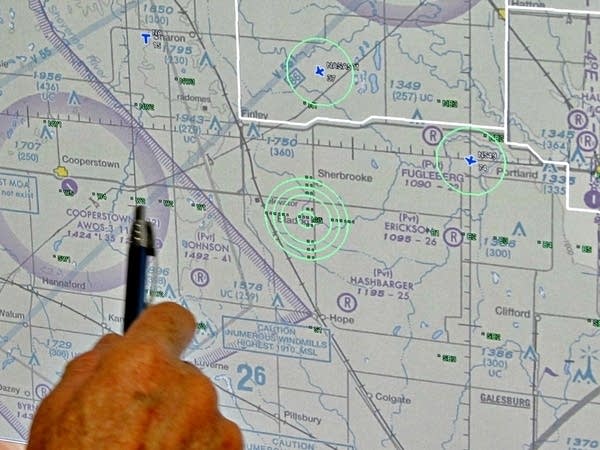Drones get crash avoidance tested to improve safety
Go Deeper.
Create an account or log in to save stories.
Like this?
Thanks for liking this story! We have added it to a list of your favorite stories.

Be observant. Don't hit anything. Pilots in the cockpit live by those rules.
Take the pilot out of the plane, though, and things get complicated.
That's the dilemma aviation researchers face as they navigate the future of unmanned aircraft. Technology has the potential to create a safe 'sense and avoid' system for drones, experts say. Onboard cameras and radar systems hold promise. But replacing a human pilot presents huge challenges. Unmanned aircraft won't fly with commercial air traffic until that critical safety hurdle is cleared.
"When you don't have a pilot on board ... you don't have the ability to look out the window and see what you're close to," said Chris Theisen, part of a University of North Dakota team working with NASA this week to test drone collision avoidance systems in the skies near Grand Forks.
Turn Up Your Support
MPR News helps you turn down the noise and build shared understanding. Turn up your support for this public resource and keep trusted journalism accessible to all.
"You're relying on all these sensors to give you that information," Theisen said. "So it comes down to, how do you test your sensors?"

This week's flights are testing a new electronic aircraft identification system the FAA plans to make a part of the next generation of air traffic control. Planes with the device constantly broadcast their location. That message is fed into a computer along with the drone's airspeed, altitude and other information. Then the computer calculates when a collision is likely and what evasive action to take.
No drones are involved in these tests. Unmanned aircraft aren't allowed to fly in the national airspace without special permits and restrictions.
So to test these safety systems, NASA created a surrogate drone -- a Cirrus single-engine aircraft that can be flown by a computer, a pilot or a control station on the ground.
In an airport conference room, researchers listen to two test pilots and watch little blue icons on a screen that show the aircraft's flight patterns. The surrogate drone and another airplane fly on a collision course. For safety, one is 2,000 feet higher, but the computer is programmed to think they're at the same altitude.
UND faculty and students started writing this software in 2007. Government and corporate researchers are also testing software programs this week.
On several tests, the computer successfully recognizes the intruder plane and takes evasive action. Other tests don't go quite as planned. At one point the computer turns the surrogate drone directly into the path of the oncoming plane. But the altitude difference prevents a crash.
And of course no software test is complete without a software crash. But these failures don't deter researchers.

It's not a pass-fail test, said Frank Jones, associate director for the NASA Langley Research Center. "None of these complex software algorithms are likely to be the single solution for preventing drone collisions."
Instead, these tests are providing basic information about how to design computer-based collision avoidance programs.
"You've got to put stress on these different algorithms - How you gonna make it fail?" Jones added. "If you can't make it fail, then you've got something you believe is good."
Researchers might be able to run as many as 100 test flights this week. These software programs have already been through millions of computer simulations.
Data from the test flights this week will help design more realistic simulations that will be run millions of times, said Andrew Lacher, a research engineer with MITRE, a government-funded research organization that runs those computer simulations.
"We have a high standard for aviation in this country for safety," Lacher said. "The FAA is not going to approve something unless it can truly be demonstrated safe. And by demonstrated, I don't mean a demo flight. I mean demonstrated with data."
How long will it be until technology allows drones to fly safely with manned aircraft? None of the researchers are willing to go out on that limb.
The stakes are high, so it has to be done right and that will take time, Lacher said.
"A civil certified sense-and-avoid solution that will work in all airspace and with all types of aircraft, that may be years away.
It's going to be a slow implementation over time of various capabilities. And what we're doing here is producing some of the data that's helping those decisions to be made."
The FAA plans to develop rules for unmanned aircraft flight sometime in 2015.
The technology needed to keep those flights safe might still be a work in progress.




